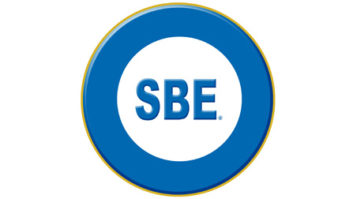The leading organization of U.S. radio and TV engineers wants the Federal Communications Commission to rethink its ideas about using C-band frequencies in support of the 5G rollout.
The FCC earlier this year invited comment on future uses of the 3.7–4.2 GHz band while protecting incumbent C-band satellite earth stations from harmful interference. The Society of Broadcast Engineers responded, saying it wants to ensure that the public continues to receive radio and television programming distributed by C-band receive stations.
The SBE offered a counterproposal to dividing the band, holding a reverse auction or other actions it says would not protect receive stations. It believes that, given the number of recent C-band registrations, the idea that the band could be shared with 5G as an overlay turns out to be wrong.
It noted that the European 5G proposal is at 3.4–3.8 GHz, which offers 1 MHz of overlap with the U.S. proposal. So SBE says the United States should adopt the European allocation, put commercial broadband providers in the 3.4–3.7 GHz band and use the small overlap segment with C band for local, private 5G networks that are important for future manufacturing and industrial applications.
“That is actually workable with C-band in the 100 MHz overlap segment,” SBE wrote in a press release. “It leaves the vast majority of the spectrum, 3.8–4.2 GHz, intact with no 5G. In contrast to other proposals, nothing is lost for current C band users with the SBE plan. 5G moves into military radar spectrum, which was already designated years ago for broadband reallocation as part of the National Broadband Plan.”
The following is excerpted from its filing in late October; the comments were signed by SBE President James Leifer and General Counsel Chris Imlay.
SBE supports compatible, flexible use of mid-band spectrum, which may include portions of the 3.7–4.2 GHz band, and is cognizant of the commission’s dedication toward making adequate provision for 5G allocations. 5G implementation worldwide is proceeding at a rapid pace. There is value to the broadcasting industry in program production using 5G technology.
However, SBE takes the commission at its word that it “proposes [in this proceeding] to protect incumbent earth stations from harmful interference” as the commission increases the intensity of terrestrial use in the band. SBE asked the commission to extend the deadline for registering pre-existing C-band receive-only Earth stations, and the commission has done so responsively and appropriately. The additional time available has resulted in a large volume of registrations which better illustrate the many thousands of C-band dishes operating in the 3.7–4.2 GHz band on a daily basis. (The programming distributed through these antennas is critical to the functioning of broadcast stations. It is expected by the public. It includes news, college and professional sporting events, music, and talk programming.)
FAULTY PREMISE

The following plot of registered downlinks [Fig. 1] … reveals graphically the difficulty in any geographic sharing arrangement between incumbent FSS Earth station users and 5G commercial operators. The vast number of registrations that has occurred since the commission opened the filing window for registrations indicates that there are likelyfar more C-band receive-only Earth stations than were assumed to exist when the commission issued its Docket 17-183 in August of 2017 or when the commission released the instant Notice. [See Fig. 2.] [SBE added in a footnote that as of late October it believed more than 16,000 C-band receive-only antenna registrations had been completed.]

Thus, the identification of the 3.7–4.2 GHz band as a candidate band for 5G rollout in the United States may have been made due to a premise that has since been shown to be inaccurate: that the number of receive-only C-band Earth stations was manageably low and that geographic separation could be used as a means of accommodating the 5G/flexible use overlay in the band. Industry sources estimate that there are well in excess of the currently registered Earth stations.
Because the commission does not have the authority to waive statutory application fees, the aggregate fees that would be necessary for some broadcasters, especially radio broadcasters, and especially those broadcast stations located in hurricane-ravaged areas such as Puerto Rico and the Gulf Coast, are prohibitively high. Broadcast licensees simply cannot afford to pay them, and the Earth stations used daily by those licensees have been and will remain unregistered, and unknown to the commission.
It would be fundamentally unfair to cut off most of the broadcasters in Puerto Rico, as but one example, from their critical source of program material that their audiences have come to need and expect, especially during the prolonged hurricane recovery, merely because those local emergency conditions and the dire economic disaster that has resulted from it have precluded their dish registrations.
LITTLE ALTERNATIVE
Broadcasters have very little alternative to the use of their existing C-band antennas at broadcast studios.
If interference from a commercial wireless provider in the 3.7–4.2 GHz band occurs and the program feed is interrupted, the broadcast programming ceases. It is not possible in most cases for cost reasons to move a C-band dish to a new location away from a studio, and program delivery by other means, such as conversion to Ku-Band program reception is cost- prohibitive.
So, in order to accommodate compatible sharing, geographic separation or frequency separation are the two options principally available. Geographic sharing is difficult as between commercial 5G service providers which depend on seamless small-cell coverage of their service areas, and the need for ubiquitous deployment of 5G would tend to negate geographic separation as an interference avoidance mechanism.
LITTLE HARMONIZATION
It is notable that, as between the United States and Europe, there is very little harmonization among proposed mid-band 5G allocations. The European Commission has identified the band 3.4–3.8 GHz as a candidate band for 5G in Europe. The allocation status of this band is currently under intensive discussion in Europe. The commission’s proposal to make the 3.7–4.2 GHz band available for flexible use in the United States would limit harmonization in the mid-band for 5G rollout as between Europe and the United States to only the 3.7–3.8 GHz band segment.
EURO MODEL
It is SBE’s position that the commission is obligated to protect the public from the loss of broadcast programming that is delivered on an ongoing, continuous basis via C-band receive-only Earth stations, the downlink frequencies for which are in the 3.7–4.2 GHz band. Broadcasters, to be protected, require that full-band, full-arc protection be provided.
One way to accomplish this, and at the same time to achieve a necessary degree of international harmonization, is to consider as an alternative for mid-band 3G rollout the band considered in Europe, 3.4–3.8 GHz. This would create far fewer compatibility issues and obviate the need for reverse auctions and other options now under consideration to deal with what is obviously otherwise a fundamental incompatibility. It would also foster international harmonization that would expedite the 5G rollout.
If the European allocation of 3.4–3.8 GHz is implemented in the United States of the 3.7–4.2 GHz band, the limited overlap between that and the C-band downlink frequencies is merely 3.7–3.8 GHz. That level of overlap could be accommodated easily and compatibly by permitting that segment to be used not by the 5G commercial broadband service providers for wide area coverage, but instead by manufacturing facilities which can implement local, private networks in that 100 MHz as part of the “Industry 4.0” or “fourth industrial revolution.”
(Industry 4.0, oversimply defined, is the digital transformation of industrial markets with smart manufacturing currently on the forefront. Also referred to as the “fourth industrial revolution” in discrete and process manufacturing, logistics and supply chain, 5G is envisioned as the key to near-term efficiency and automation in the chemical industry, energy, intelligent transportation, utilities, oil and gas, mining and metals and other segments, resources industries, healthcare, pharmaceuticals and even smart cities.)
FLEXIBLY DEPLOYED
5G is incorporated in short-term planning for flexible manufacturing in both the United States and Europe and the spectrum therefor can be harmonized within the band segment available in common: 3.7–3.8 GHz. The German Federal Network Agency (Bundesnetzagentur) has proposed that the band 3.4–3.7 GHz would be allocated and assigned by auction to traditional mobile broadband providers. The 3.7–3.8 GHz segment, however, would be flexibly deployed on local, limited-range licensed basis, and used locally by individual manufacturing and industrial entities. The local deployment by private sector manufacturing of local, private 5G networks would be a key component to the rollout of 5G in support of Industry 4.0 initiatives in manufacturing and industrial applications. As is the case with today’s Wi-Fi hotspots, the manufacturing industry seeks to manage its own individual 5G networks without those networks being under the control of commercial mobile broadband service providers. There are several reasons for that, including liability issues and intellectual property protection and security.
PATH TO SUCCESS
It is understood that the commission has proposed in the notice to work upward from 3.7 GHz toward 4.2 GHz in the deployment of 5G in this band. That plan is entirely consistent with the proposed availability of 3.7–3.8 GHz for licensed or unlicensed, private, local 5G industrial applications, leaving the remainder of the band 3.8–4.2 intact for FSS downlink antennas.
However, if the European planned allocation is implemented in the United States, the commercial providers could use the remainder of 3.4–3.7 GHz for commercial 5G wide area systems. The plan for flexible access of individual companies to the 3.7–3.8 GHz sub-band provides a path to success for numerous industry sectors engaged in industrial manufacturing, chemical and pharmaceutical manufacturing, energy generation, healthcare, smart transportation systems, and news and entertainment program production (especially relative to special events), among many other applications.
RETAINING PROTECTIONS
Authorizing 3.7–3.8 GHz local, private 5G networks is also consistent with the commission’s stated intention to protect the many thousands of incumbent C-band downlink Earth stations in the 3.7–4.2 GHz band. Given the relatively low power levels needed for local, private 5G networks, the relatively short path distances involved; the likely geographic separation between industrial manufacturing facilities and broadcast studios (which could be ensured by either limited, local licensing or registration of 5G manufacturing facilities in the 3.7–3.8 GHz band); and especially taking into account the small portion of the overall 3.7–4.2 GHz C-band spectrum at issue, the local, private 5G networks would provide a compatible but partial overlay on spectrum heavily used for C-band satellite downlinks.
RELOCATION PROGRAM?
Should the commission, for some reason now unknown, be unable to adopt SBE’s suggestion to convert 5G rollout in the mid-band to the 3.4–3.8 GHz band in lieu of the 3.7–4.2 GHz band, then the commercial mobile broadband service providers who would deploy 5G commercial networks in the band segment 3.8–4.2 GHz in the United States should be in a position to, and should either pay all costs of relocation of incumbent C-band downlinks to another band in order to permit rollout in the 3.8–4.2 GHz band, or to accept whatever geographic separation requirements are ultimately deemed necessary to absolutely protect incumbents who register their existing receive-only Earth stations prior to the close of the C- band filing window, against interference from commercial 5G network overlays.
But the commission should provide protection for unregistered C-band dishes in locations such as Puerto Rico and the Virgin Islands, where hurricane recovery has necessarily superseded all other considerations. It would be unfair and discriminatory to penalize hurricane-ravaged areas by failing to protect unregistered C-band Earth Stations in those areas.
CONCLUSIONS
For all of the above reasons, SBE is of the view that:
(1) protection of C-band services and ongoing full-arc protection of existing C-band facilities is critical;
(2) the commission’s premise for proposing the 3.7–4.2 GHz band for 5G rollout in the mid-band, that there is a presumptively low number of incumbent C-band downlink Earth stations has been shown to be patently false;
(3) there is no cost-effective substitute for C-band Earth stations for broadcast program delivery;
(4) there is compatibility between licensed (or unlicensed with registration, a process in which SBE could assist) private, local 5G manufacturing pursuant to Industry 4.0 concepts and C-band downlink facilities, properly managed and with appropriate coordination in the band segment 3.7–3.8 GHz; and
(5) the commission should otherwise refocus on timely rollout of 5G mobile and fixed operation in the 3.4–3.8 GHz band, with the top 100 megahertz to be used only for local, private networks which can be sited and configured so as to not interfere with C-band receive-only Earth stations.
Therefore, the foregoing considered, the Society of Broadcast Engineers hereby respectfully requests that the commission make 5G technology available on a flexible, unlicensed basis as proposed hereinabove, and not otherwise.
Comment on this or any story to [email protected] with “Letter to the Editor” in the subject field.










